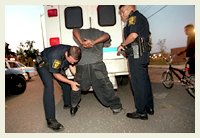The drug-fueled violence along the US border with Mexico–the subject of an excellent piece in the New York Times on Monday–has reached fever pitch. Since January 2008, some 7,000 people have been killed (descriptors like dissolved in acid, butchered, burned, or decapitated may be a more apt) across Mexico. There appears to be no end in sight to the violence, despite intervention by the Mexican military, among the only state entities believed to be relatively free of contamination by the cartels.
Several drug lords have been arrested in recent years, but, ironically enough, it has only accelerated the bloodletting as ambitious up-and-comers have vied for control of lucrative smuggling corridors. (This is not a new problem. Read Terrence Poppa’s narco-classic Drug Lord for an insider’s view of how the Mexican drug business functions.)
But don’t let history and the facts get in the way. The Mexican government, in advance of this week’s scheduled visit by Secretary of State Hillary Clinton, placed bounties on 24 of the country’s most-wanted cartel leaders, offering $2 million for information leading to the capture of any one of them. Additional $1-million rewards were offered for 12 lower-level drug smugglers. It seems doubtful that this will make much difference. First, drug lords are scary guys, and the intimidation factor (something they work hard to achieve) looms large. Second, as scary as they are, historically speaking, they also invest in local communities, give to charity, and are often seen as local heroes.
The $25 million bounty on Osama Bin Laden’s head has so far gone uncollected. Should we expect these arguably more powerful and scary guys in Mexico will be sold out for less?














